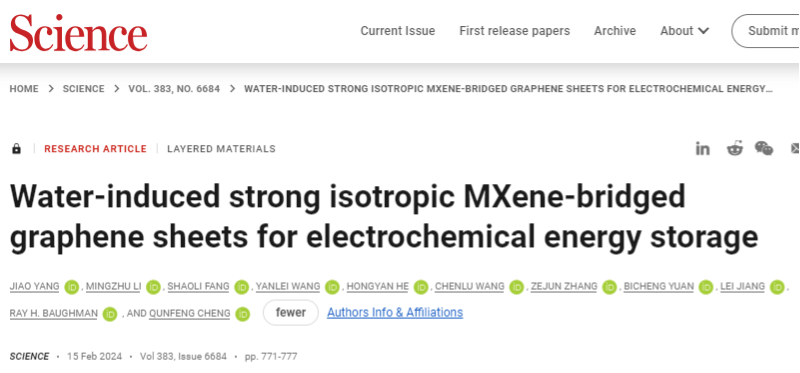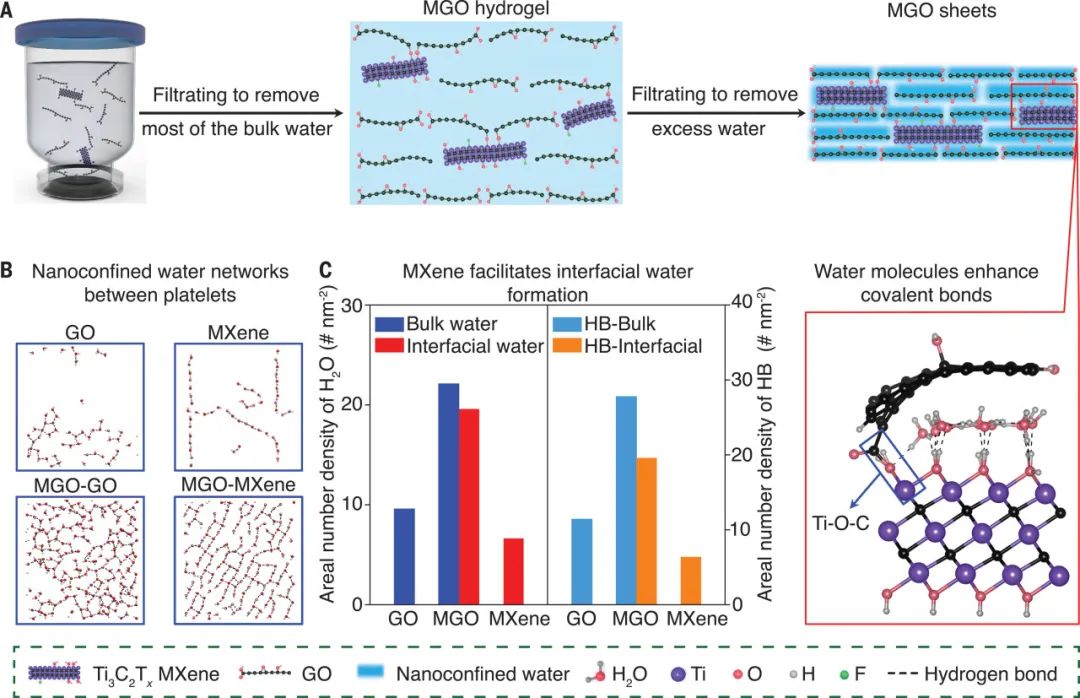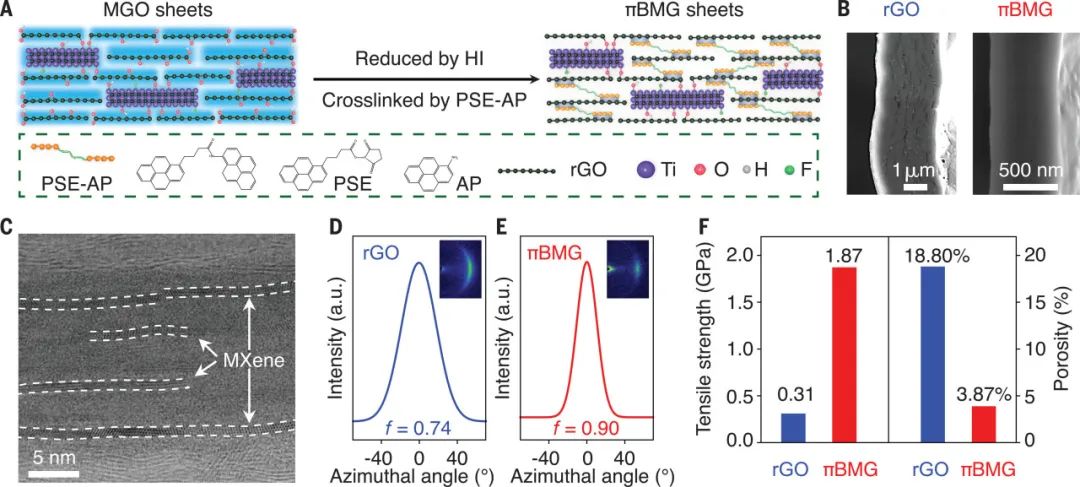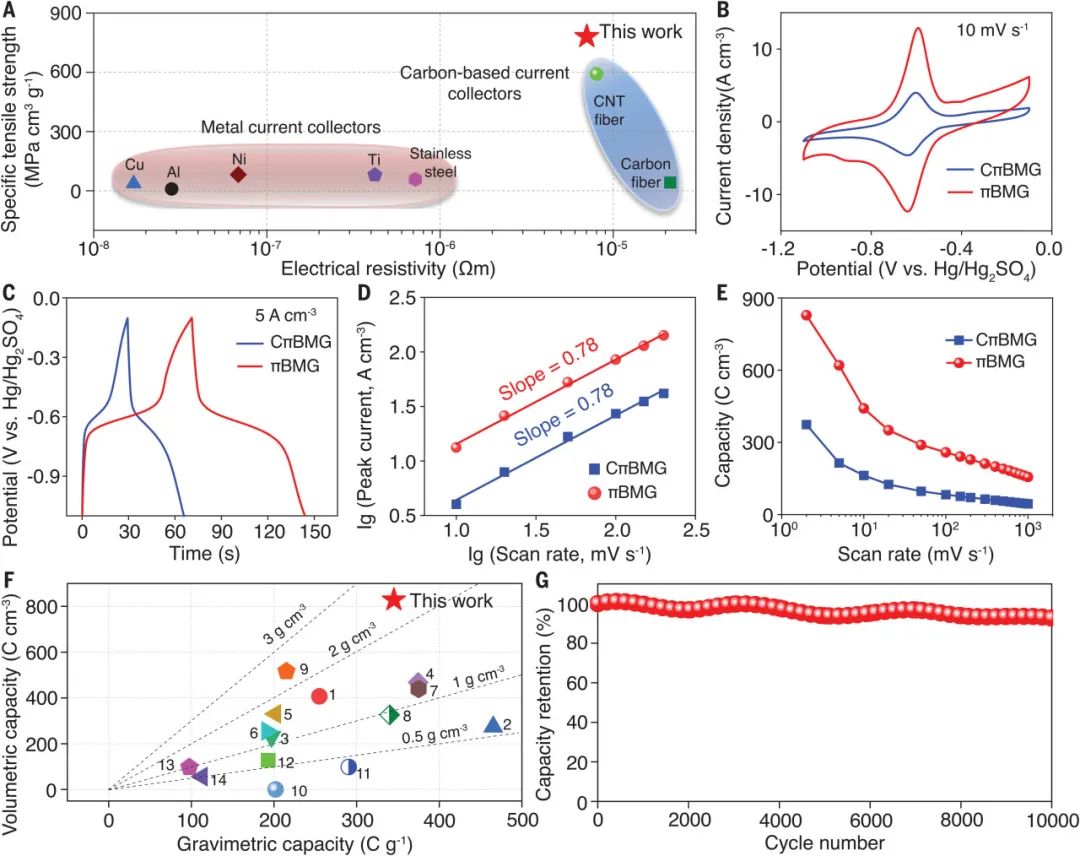On February 16, 2024, the journal Science reported the latest progress in nanocomposites research entitled "Water-induced strong isotropic MXene-bridged graphene sheets for electrochemical energy storage", which was made by Prof. Cheng Qunfeng 's team from the School of Chemistry, Beihang University . The research for the first time used nanoconfined water to fabricate Ti3C2Tx crosslinked graphene at room temperature and atmospheric pressure with isotropic in-plane tensile strength of 1.87 gigapascals, which provides a new strategy for the ordered assembly of other two-dimensional materials [Science 2024, 383, 771].

Yang Jiao, a doctoral candidate of the School of Chemistry, Beihang University, is the first author. Li Mingzhu, a researcher at the Technical Institute of Physics and Chemistry, Chinese Academy of Sciences, Fang Shaoli, a professor at the University of Texas at Dallas, and Wang Yanlei, an associate researcher at the Institute of Process Engineering, Chinese Academy of Sciences, are the co-first authors. Prof. Cheng Qunfeng is the first corresponding author and Prof. Ray H. Baughman from the University of Texas at Dallas is the corresponding author of the cooperating unit.

On October 1, 2023, the Ministry of Industry and Information Technology, the Ministry of Science and Technology, the Ministry of Finance, and the Civil Aviation Administration of China jointly issued the "Outline for the Development of Green Aviation Manufacturing Industry (2023-2035)", which points out that the development of green aviation manufacturing industry is an inevitable requirement to respond to climate change and achieve sustainable development of the aviation industry. Among them, lightweight materials are one of the key core technologies for green aviation development. At present, Boeing 787, Airbus A350 passenger aircraft, C919 passenger aircraft use carbon fiber reinforced materials in large quantities to achieve weight reduction and energy saving. Compared with carbon fiber, two-dimensional nanomaterials such as graphene and titanium carbide ( Ti3C2Tx) have more excellent mechanical and electrical properties, which are ideal materials to achieve the goal of green aviation in the future. How to realize the excellent intrinsic properties of 2D nanomaterials in macroscopic assemblies is a key scientific problem to be solved in this field.
Prof. Cheng Qunfeng's team from Beihang University has long been devoted to the research of biomimetic nanocomposites, and has made a series of important research advances (Science 2021, 374, 96.; Nat. Mater. 2021, 20, 624.; PNAS 2020, 117, 27154.; Nat. Commun. 2020, 11, 2077. 2077.; PNAS 2020, 117, 8727.; Nat. Commun. 2022, 13, 7340.). By learning from nature, Prof. Cheng Qunfeng's team developed a green biomimetic construction strategy for nanocomposites, invented ordered chemical cross-linking and its synergistic strategy, and created high-strength conductive and lightweight functional nanocomposites. Recently, Prof. Cheng Qunfeng has proposed a nanoconfined assembly strategy to assist 2D nanomaterials assembly through nanoconfined water, which eliminates the folding of 2D nanomaterials due to capillary shrinkage, solves the key scientific problems of 2D nanomaterials assembled by wet-chemical method which are not structurally dense and with low degree of orientation, and realizes a breakthrough in the mechanical properties of nanocomposite materials.

Fig. 1. Schematic illustration of the preparation and structure of mutually aligned MXene and GO nanoplatelets obtained with nanoconfined water

Fig. 2. Structural characterizations of GO, MXene, and MXene-bridged GO (MGO) sheets
The research mainly includes three key points: nanoconfined domain effect to improve compactness and orientation, room temperature and atmospheric pressure construction strategy for green and low-carbon manufacturing, and regularized structure to facilitate high-density energy storage in nanocomposites.

Fig. 3. Schematic illustrations of the fabrication and structure of in-plane isotropic MXene-bridged graphene (πBMG) sheets

Fig. 4. Properties of rGO sheets and in-plane isotropic MXene-bridged graphene (πBMG) sheets

Fig. 5. Electrochemical performance of capillary-dried π-π bridged MXene-bridged graphene (CπBMG) and in-plane isotropic MXene-bridged graphene (πBMG) sheets
In this research, the team transformed the bulk water into confined water that accumulates into an ordered state. This study realized the alignment of nanoplatelets through the introduction of nanoconfined interplatelet water molecules, preventing nanoplatelet wrinkling and resulting in the compact stacking of parallel MXene and graphene nanoplatelets. The resulting πBMG sheets exhibited exceptional mechanical properties. This nanoconfined water-induced alignment likely provides an important approach for making other aligned macroscopic assemblies of two-dimensional nanoplatelets.
The study was supported by the National Key Research and Development Program of China (grant 2021YFA0715700), the National Science Fund for Distinguished Young Scholars (grant 52125302), the National Natural Science Foundation of China (grants 52350012 and 22075009), and the 111 Project (grant B14009).
Link to the article: https://www.science.org/doi/10.1126/science.adj3549
Cheng Qunfeng's group website: http://chengresearch.net/zh/home-cn/
Reviewed by: Li Jianwei
Edited by: Jia Aiping, Yao Zipeng
Translated by: Yao Zipeng

